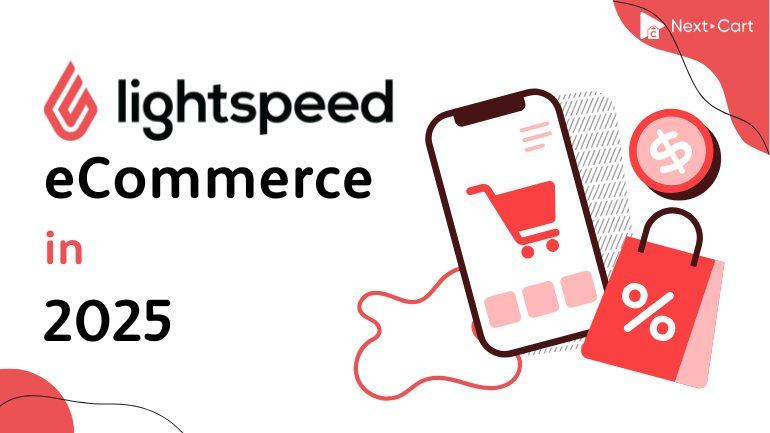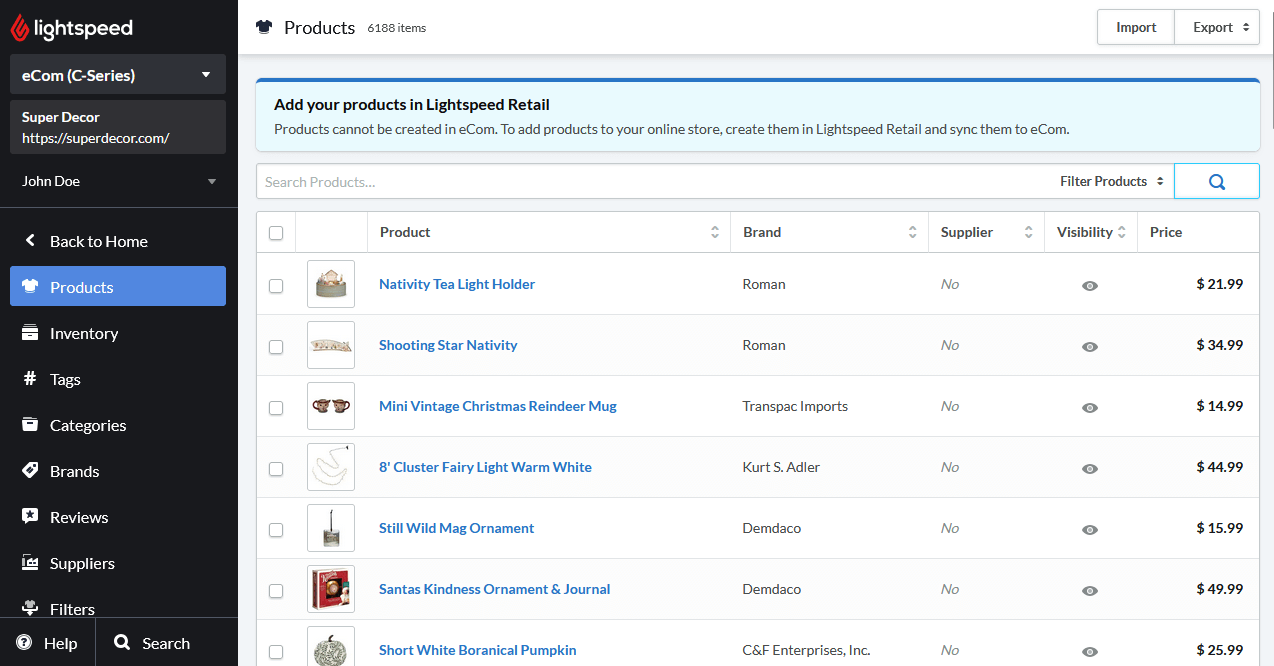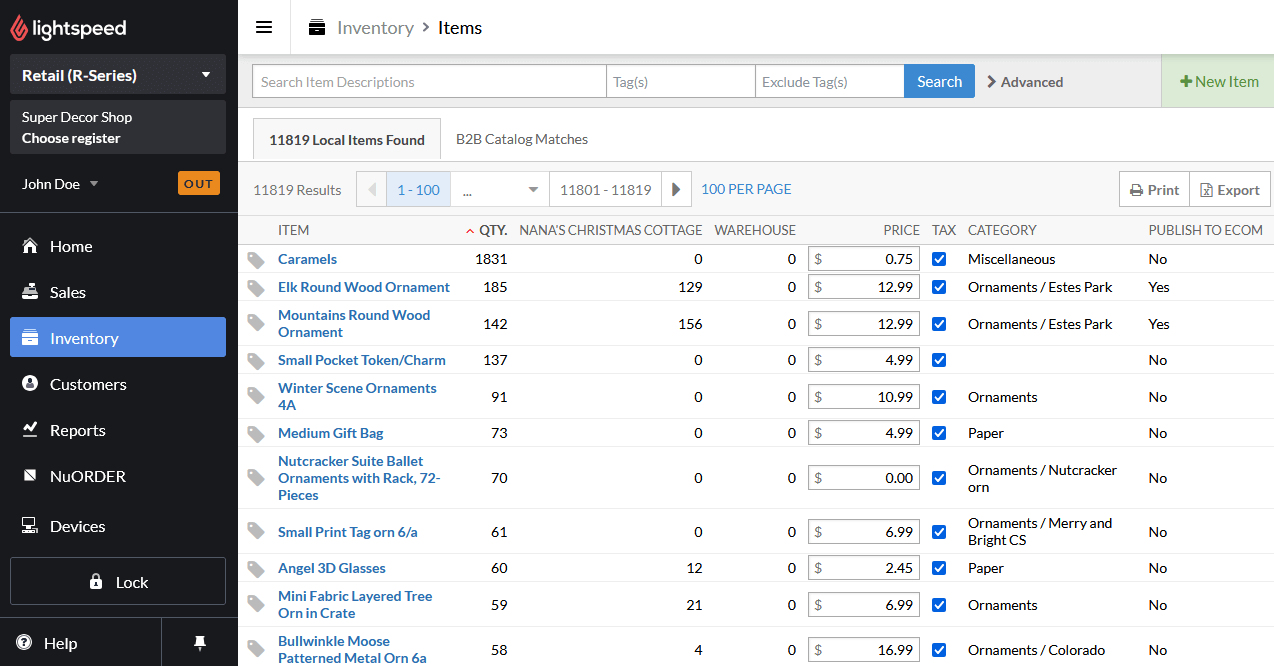
Digital commerce now demands platforms that can adapt to its diverse needs. In that circumstance, Lightspeed, originally a POS system, has transformed into a comprehensive eCommerce ecosystem to serve various industries. The Lightspeed eCommerce platform has even acquired the Ecwid and Vend platforms to expand its capabilities and serve businesses of all sizes. It offers tailored operational solutions instead of requiring businesses to adapt to their systems.
This 2025 review of the Lightspeed platform will examine its current offering, including inventory management, omnichannel integration, and other business features, and explain why it is an excellent choice for businesses with both physical and digital commerce needs. Let’s figure out if Lightspeed fits your business needs in 2025!
- Overview of What the Lightspeed eCommerce Platform Does
- Why is Lightspeed a Complete eCommerce Platform?
- Key Features of the Lightspeed eCommerce Platform
- Omnichannel Capabilities
- Integration between physical and online stores
- Unified inventory management
- Cross-platform customer data
- Payment Solutions
- Analytics and Reporting
- Integration Ecosystem
- Pricing Structure
- Competitor Comparison
- Pros and Cons of Lightspeed eCommerce Platform
- In Conclusion
Overview of What the Lightspeed eCommerce Platform Does
Lightspeed eCommerce is a multichannel software in which retailers can build and manage online stores. As a cloud-based eCommerce platform, Lightspeed unifies store management through a single system. Merchants can easily control their physical and online inventory, access comprehensive customer data, and track multi-channel sales through one dashboard.
The platform offers users customizable templates to organize their products and enhances website navigation and customer experience. Moreover, businesses can import data via CSV or XLS files, customize pricing, and create discount codes through a central dashboard. Lightspeed also supports social media connections with excellent built-in SEO tools to maximize online marketing. It provides retailers with detailed and valuable analytics on website sales performance and customer conversion metrics.
Why is Lightspeed a Complete eCommerce Platform?
Lightspeed is a comprehensive eCommerce platform as well as an advanced point-of-sale (POS) system.
A Complete eCommerce Platform

Lightspeed eCom
The online store builder Lightspeed includes flexible templates and customizable options. These features help merchants create brand consistency in their online presence with no need for coding knowledge.
Users can make use of its drag-and-drop editor to quickly update product pages, promotions, and content blocks. They can still maintain mobile responsiveness then.
Meanwhile, the built-in SEO tools help optimize product listings for search engines, as a result, improving visibility and driving organic traffic to the online store.
Offering multichannel selling, Lightspeed connects to major marketplaces like Amazon, eBay, and Facebook Shops. Moreover, users can benefit from this feature through an only centralized dashboard. It integrates inventory, orders, and customer data across all sales channels to eliminate manual updates and human errors.
Lightspeed also provides a unified reporting system with clear insights into channel performance. This feature helps merchants allocate resources to the most profitable platforms in the market.
This complete eCommerce platform also excels in responsive design and dedicated mobile app options that enhance mobile commerce capabilities for online websites. It automatically optimizes the shopping experience for smartphone users. Furthermore, to drive more conversion rates on smaller screens, it offers one-click checkout, mobile payment options, and location-based promotions that are essential for mobile shopping cart completion.
A Robust Retail POS System

Lightspeed R-Series POS
Lightspeed’s retail point-of-sale system has transformed physical stores with brick-and-mortar operations. The system can handle complex transactions on online stores and support various payment methods. At the same time, it provides detailed sales reports that help store owners identify trends and make their marketing decisions. Its staff management tools also streamline the scheduling and employee performance tracking of managers and help optimize their workforce.
If we must choose the strongest retail feature of this robust retail POS system, it should be their inventory management capabilities. The platform offers impressive real-time stock tracking across multiple locations. In addition, store owners can set automatic reorder points, manage purchase orders, and reconcile inventory discrepancies. All those duties can be processed through the intuitive interface. Its advanced matrix inventory is ideal for businesses that have to manage their products with multiple variations like size, color, and style.
Lightspeed’s retail POS also features excellent customer relationships, in which it can help stores create personalized shopping experiences by analyzing customer profiles. The system stores purchase history, preferences, and contact information of interested customers. Then, it utilizes that information to enable targeted marketing campaigns and loyalty programs to drive repeat business.
In the meantime, email marketing tools are integrated, allowing retailers to automatically send follow-ups and promotional messages. The system processes all those tasks based on customer behavior to increase engagement and conversion rates.
Key Features of the Lightspeed eCommerce Platform
Lightspeed integrates a robust suite of capabilities for retail operations across multiple channels with seamless omnichannel experiences for businesses.
Omnichannel Capabilities
Integration between physical and online stores
Lightspeed integrates brick-and-mortar and digital stores by synchronizing inventory across all sales channels in real time. When a product sells in-store, online inventory adjusts automatically to provide accurate stock information no matter where customers shop.
The platform helps track product movements, adjust inventory quantities instantly, and send store managers low-stock alerts and automated reorder notifications.
At the same time, the platform generates detailed inventory reports and sales analytics to help store owners make data-driven purchasing decisions. As a result, this feature eliminates manual counting and human error. The integration between physical and online stores prevents overselling and maintains accurate stock levels across all channels.
Unified inventory management
Retailers can monitor stock levels, set automatic reorder points, and manage transfers between locations through a single dashboard. For retailers with multiple locations, Lightspeed offers inventory management for each specific store while maintaining an overview of all stock.
Cross-platform customer data
Lightspeed collects and consolidates customer data across all shopping channels. Therefore, users can create comprehensive customer profiles with their purchase history, preferences, and interactions. This valuable information contributes to the success of personalized marketing campaigns and targeted promotions, including loyalty programs that accumulate customer points and rewards regardless of purchase channel.
Payment Solutions
Available payment gateways
Lightspeed is a payment ecosystem with advanced gateway integration features. It supports recurring billing and subscription management. It allows retailers to establish predictable revenue streams through automatic recurring payments for subscription-based products.
Lightspeed eCommerce integrates with numerous payment gateways, including PayPal, Stripe, Square, and Authorize.net. The platform also supports common payment methods in a specific region in order to cater to local market preferences.
Its multi-currency capabilities are particularly sophisticated, with automatic currency conversion. At the same time, the platform also handles tax calculations across different jurisdictions to automatically apply the correct rates.
Security features
Lightspeed applies advanced security measures, including PCI DSS compliance and tokenization of sensitive payment information to flag suspicious transactions. The platform also implements 3D Secure authentication for credit card transactions. It employs encryption for all data transmissions to protect both merchant and customer information.
Analytics and Reporting
Sales analytics
The platform users can receive comprehensive sales data by product, category, time period, and sales channel. Lightspeed eCommerce generates automatic reports on revenue trends, best selling items, profit margins, and sales performance by staff members.
Inventory insights
The inventory analytics tools monitor each product’s turnover rates, days-on-hand, and seasonal demand patterns. The system can identify slow-moving merchandise and suggest stocking levels based on historical sales data.
Customer behavior tracking
This feature helps merchants analyze customer shopping patterns, purchase frequency, average order value, and lifetime customer value. The platform can even point out browsing behavior, abandoned cart rates, and conversion funnels to highlight areas for website optimization. Users can benefit from heat mapping to know how customers interact with product pages and cohort analysis to understand retention patterns across different customer segments.
Integration Ecosystem
Lightspeed connects businesses to a wide range of third-party applications and enterprise resource planning systems. The platform extends its power through this comprehensive integration ecosystem.
Third-party app marketplace
Lightspeed eCommerce comes with a robust app marketplace to extend its native functionality. This ecosystem includes hundreds of pre-built integrations that allow merchants to customize their specific tech stack. The marketplace offers specialized solutions for marketing automation, customer relationship management, and advanced shipping logistics and inventory management. Many integrations offer free trials or tiered pricing models.
API capabilities
Lightspeed’s comprehensive API access enhances the pre-built marketplace integrations. The RESTful API architecture accommodates data retrieval and modification. Therefore, developers can create custom applications with core Lightspeed functions of inventory, orders, customers, and products. In addition, the platform supports webhooks for real-time data updates in which systems can react immediately to changes in new orders, inventory adjustments, or customer activities.
Enterprise resource planning (ERP) connections
Lightspeed eCommerce offers specialized connectors for major ERP systems, including NetSuite, SAP, Microsoft Dynamics, and Sage. These integrations synchronize all business data, including inventory levels, product information, pricing, and customer records between systems.
The ERP connections allow configurable field mapping to accommodate diverse data structures and business rules. As a result, retailers can maintain their established ERP workflows while they can still add Lightspeed’s eCommerce capabilities. Moreover, the system includes data validation tools to identify potential conflicts before synchronization.
Pricing Structure
Lightspeed eCommerce offers a tiered pricing structure. Its subscription model begins at $109.00 per month for the basic package. Each successive tier provides additional functionality and capacity that serve larger operations.
Transaction fee structures vary by payment gateway. The typical rates range from 2.6% to 2.9% plus a fixed fee per transaction. Lightspeed offers volume discounts as transaction numbers increase.
Lightspeed positions itself as a comprehensive retail management solution rather than simply an online store builder. That’s why it focuses on an integrated approach to create greater value than entry-level alternatives. Shopify or WooCommerce may offer lower initial entry costs, however, Lightspeed tends to provide better long-term value for retailers with both online and physical stores. It combines separate systems for different sales channels to reduce operational complexity and administrative overhead.
On the other hand, compared to specialized enterprise solutions like Salesforce Commerce Cloud or Adobe Commerce, Lightspeed is much more affordable while still providing advanced eCommerce capabilities for mid-market retailers.
Competitor Comparison
Let’s examine Lightspeed’s positioning against leading eCommerce solutions, including Shopify, Square, and BigCommerce.
Lightspeed vs. Shopify
Shopify excels in user-friendly interfaces and extensive templates. Therefore, it is an ideal eCommerce platform for beginners. Meanwhile, Lightspeed focuses on more established retailers who often require advanced inventory management and omnichannel integration between physical and online stores.
Regarding POS, while Shopify has added this feature, Lightspeed is superior thanks to its unified system with seamless inventory synchronization across channels.
In addition, Lightspeed offers better variant handling and bulk editing for complex product catalogs. Also, the native B2B functionality is available with Lightspeed, while it requires add-ons in Shopify.
With pricing models, Shopify’s transaction fees for third-party payment processors become costly at higher volumes. Meanwhile, Lightspeed typically costs less for businesses with both online and physical operations.
Lightspeed vs. Square
Square began as a payment processor before expanding to eCommerce, while Lightspeed originated as a retail POS management system. That’s why Square has more advantages for creating simpler payment processing with transparent pricing. The Lightspeed counterpart includes basic eCommerce functionality without monthly fees, so it is more appealing to very small merchants.
However, Lightspeed provides better inventory management for advanced purchase order systems, supplier integration, and automated reordering that are complex catalogs.
In short, while Square wins on simplicity, Lightspeed offers better capabilities to expand your businesses.
Lightspeed vs. BigCommerce
Both platforms target established retailers. However, BigCommerce features superior native SEO capabilities and better built-in international selling tools. Therefore, this plarform is considered stronger for the goal of expanding globally. Meanwhile, like the other alternatives, Lightspeed has better omnichannel integration between physical and online operations.
BigCommerce provides more flexible headless commerce options that facilitate custom development, but it means greater technical resources are required.
BigCommerce offers revenue-based pricing tiers that force growing businesses into higher plans. On the other hand, Lightspeed has a more predictable pricing structure that benefits businesses balancing physical and online sales channels.
Pros and Cons of Lightspeed eCommerce Platform
Advantages
- Flexibility: Lightspeed eCommerce can adapt across different retail environments, from single-store operations to multi-location enterprises. The system scales with business growth. It also accommodates various retail verticals, including apparel, electronics, and specialty goods.
- Feature richness: The platform provides comprehensive functionality, including inventory management, order processing, customer relationship management, and marketing tools, all in a single integrated system.
- Integration: Lightspeed offers extensive API and pre-built connectors. It enables seamless integration with leading ERP systems, marketing platforms, and specialized retail tools. This connectivity creates a cohesive ecosystem to support unified operations.
Limitations
- Learning curve: With its extensive features, Lightspeed requires a steeper learning curve compared to simpler eCommerce solutions. New users must get dedicated training to fully leverage its advanced functionality.
- Costs: While it is competitive for its capabilities, the subscription pricing model is at a higher price than basic eCommerce platforms. Users must also consider additional costs for specialized integrations, premium support, and transaction fees into total ownership calculations.
In Conclusion
Lightspeed has proven its value through its robust feature set, seamless integrations, and dedicated support system. The platform provides excellent inventory management, multi-channel sales, and detailed analytics. Despite its higher pricing tier, the ROI growing businesses can achieve will be appealing. Lightspeed eCommece is considered a top choice for a comprehensive eCommerce solution in 2025.
Considering moving to the Lightspeed platform? eCommerce migration experts will help you go through a seamless transition for comprehensive data transfer and custom theme development. Our team at Next-Cart can manage your product catalog, customer data, and order history throughout the migration process while still preserving your SEO rankings. We say no to the downtime migration process, keeping your business running smoothly. Our team has successfully migrated hundreds of stores to and from Lightspeed. Let’s talk about your migration planning!